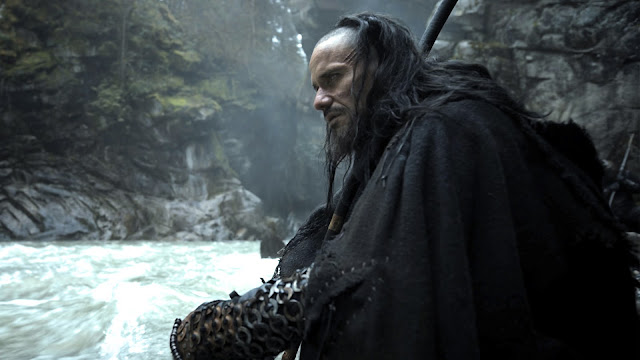“If you want me out, you’re gonna have to cut me yourself, sir.” — Tracy Stevens in “For All Mankind”
It’s kind of nice when a TV series surprises you.
When I say “surprise,” I’m not necessarily referring to a bunch of twists, turns, and shocking cliffhangers you don’t see coming — although, the series I’m talking about has plenty of narrative loops to keep you intrigued throughout.
The Apple TV+ series “For All Mankind” looks at the early days of the “space race” through an alternate history lens.
Instead of Neil Armstrong being the first man to step foot on the moon in 1969, “For All Mankind” imagines a world where Soviet cosmonaut Alexei Leonov is the first man on the celestial body.
That wrinkle sets into motion a series of events that forever changes the global space race between the United States and the U.S.S.R.
More to the point, the space race becomes the arena where the Cold War is fought, and NASA’s de facto role finds the agency developing technologies in a tit-for-tat tussle with the Russians for interstellar supremacy.
Going into “For All Mankind,” I was expecting a schmaltzy bit of revisionist history — a story that leaned on nostalgia for the early days of space exploration as its hook. I wasn’t expecting a lot of depth.
I was wrong.
My initial perception was incorrect and the narrative structure is so much more than the promos led me to believe.
Much in the way a period drama like “Mad Men” used "midcentury advertising” to explore the socio-political issues impacting the country in the 1960s and 1970s, “For All Mankind” employs a similar technique as it explores the lives of the men and women working in the space program.
Sure, things can get a bit melodramatic at times. That said, watching the lives of the people behind the NASA program in the series (told from personal and professional perspectives) makes for a pretty compelling drama.
“For All Mankind” was the brainchild of Ronald D. Moore.
Moore is a screenwriter and producer whose talents have been on display in TV series like 1990s-era “Star Trek” and the wildly popular 2000-era reboot of “Battlestar Galactica.”
While the visuals and set design are immersive in “For All Mankind,” it is the human drama that kept Bridget and me tuning in. We see fictional characters intermingling with historical figures in a way that brings a sense of verisimilitude to the episodes.
I found a number of the characters to be interesting.
In particular, the two couples at the core of the show’s main plotline anchor the drama.
Astronaut Ed Baldwin (Joe Kinnaman) and wife Karen (Shantel VanSanten) epitomize the straight-arrow, WASP-y families found in postwar suburbs across the U.S. in the 1960s.
Acting as a counterpoint to the Baldwin clan is Astronaut Gordo Stevens (Michael Dorman) and wife Tracy (Sarah Jones). Gordo’s philandering ways harm his marriage, and his restless wife is yearning for a path beyond that of a stay-at-home mom.
As we watch the interplay between these couples and their families, we see characters who are allowed to change and evolve as the first season’s 10-episode arc progresses.
At the beginning of the first episode, the couples seemed like they were in place to serve an archetype of the period. But as things moved along, it was nice to see each of those four characters “breathe” (narratively speaking). They became multi-dimensional as a result.
While both of those couples anchor the show, it is the supporting cast that gives “For All Mankind” its flavor. There are a number of good performances during the first season.
In particular, I thought Lenny Jacobson’s performance as Wayne Cobb (an affable counter-culture artist in the series) was particularly good. I don’t want to talk too much about the performance (because I don’t want to reveal any spoilers), but smaller roles like his made the first season interesting.
I also enjoyed Wrenn Schmidt as NASA engineer Margo Madison. Her character is quietly intense as she navigates politics and social norms of the time as the first woman in Mission Control. When the series begins, we learn that she has been mentored by Wernher Von Braun (Colm Feore). As the series progresses, she pays that tutelage forward when she takes Aleida Rosales (Olivia Trujillo) — the daughter of a NASA custodian — under her wing.
“For All Mankind” has certain elements that will remind viewers of movies like “Apollo 13” and “The Right Stuff,” as well as TV shows like 1984’s “Call To Glory.”
The show’s main title is composed by Jeff Russo. Russo has had a fairly prolific career (primarily composing TV theme songs). His credits include opening themes for properties in the “Star Trek” franchise (he most recently composed the theme for “Star Trek: Picard”).
The title track he composed for “For All Mankind” sounds like it could be a “Star Trek” score (it is both epic and inspiring):
The show’s soundtrack also features recognizable pop songs from the 1960s and 70s. The first season of “For All Mankind” spans the period of time between 1969 and 1974.
As I mentioned earlier, the show strives for an authentic look and feel. This featurette dives into the production design for the first season. Set designers had access to actual tools used by NASA during the era, and the show’s costume designer thumbed through old Sears Catalogs for inspiration:
Overall, I thought “For All Mankind” was an engrossing drama. I went in with lukewarm expectations and was surprised how much I enjoyed it.
I’ve praised other offerings on Apple’s budding streaming service, but this is one of the best in the lineup. There is a lot to like in the first season.
By the way, be sure to watch through the end credits of the final episode (Episode 10 “A City Upon a Hill”) for a post-credit “Easter egg.”
Previous post: Movie Review: “Greyhound” (Apple TV+ Original Movie)
































